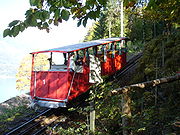
Giessbachbahn
Encyclopedia

Funicular
A funicular, also known as an inclined plane or cliff railway, is a cable railway in which a cable attached to a pair of tram-like vehicles on rails moves them up and down a steep slope; the ascending and descending vehicles counterbalance each other.-Operation:The basic principle of funicular...
at Giessbach in the Swiss
Switzerland
Switzerland name of one of the Swiss cantons. ; ; ; or ), in its full name the Swiss Confederation , is a federal republic consisting of 26 cantons, with Bern as the seat of the federal authorities. The country is situated in Western Europe,Or Central Europe depending on the definition....
Canton of Berne
Canton of Berne
The Canton of Bern is the second largest of the 26 Swiss cantons by both surface area and population. Located in west-central Switzerland, it borders the Canton of Jura and the Canton of Solothurn to the north. To the west lie the Canton of Neuchâtel, the Canton of Fribourg and Vaud. To the south...
. It links a landing stage on Lake Brienz
Lake Brienz
Lake Brienz is a lake just north of the Alps, in the Canton of Berne in Switzerland. The lake took its name from the village Brienz on its northern shore. Interlaken and the villages Matten and Unterseen lie to the south west of the lake. The shores are steep, and there is almost no shallow water...
, served by shipping services on the lake, to the Grand Hotel Giessbach and waterfall above. The funicular is owned by the hotel, but since 1983 has been operated by a preservation foundation.
The funicular, opened in 1879, was the first Swiss funicular to be built specifically for the transport of tourists and is the oldest funicular continuously operating in Europe. It has a length of 345 metres and overcomes a vertical distance of 104 metres with a maximum gradient of 32%. There are two wooden cars dating from 1879, operating on a single track of metre gauge
Metre gauge
Metre gauge refers to narrow gauge railways and tramways with a track gauge of . In some African, American and Asian countries it is the main gauge. In Europe it has been used for local railways in France, Germany, and Belgium, most of which were closed down in mid 20th century. Only in Switzerland...
track with a central passing loop and a Riggenbach rack rail for braking purposes. Originally operated by water ballast, the funicular is now electrically operated and a single journey takes 2 minutes.

